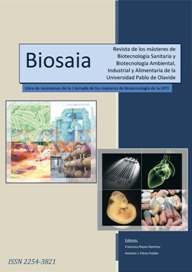The inclusion of side metabolic reactions in the genome-scale metabolic model of Pseudomonas putida highlights to underground metabolism as key player in metabolic robustness
Palabras clave:
Underground metabolism, Genome scale-modeling, System Biology, Biotechnology, Pseudomonas putida, Bacterial evolutionResumen
Understanding evolutionary process in which organisms develop new metabolic traits and pathways to face changing environmental conditions is one the paradigms in Biology and a fundamental aim in System Biology. Contrary to what is believed, biochemical reactions far to be highly substrate-specific, exhibit large promiscuous activities. In fact, in the most of the cases they present very weak activity towards alternative substrates. This phenomenon, also known as side reactions, drives the so-called underground metabolism which is seen as the starting point for the generation of new metabolic activities, even new pathways allowing the adaptation to new environments [1]. The soil bacterium Pseudomonas putida is a model bacterium with a robust and complex metabolism [2] whose genome scale-model has been widely developed [3]. In an attempt to understand how new metabolic traits emerge in this model bacterium, we have updated the current genome-scale model of P. putida and included the underground metabolism based on the available biochemical information. Computational analysis of the new metabolic space provided by this model expansion allow us to provide solid evidences of the role of underground metabolism as guarantor of the metabolic robustness of against genetic and nutritional perturbations in P. putida. In fact, following model predictions it was possible to expand the metabolic versatility towards the use of N-Acetyl-L-Alanine as a carbon source through Adaptive Laboratory Evolution (ALE) approaches. Additionally, ongoing-omics approaches will provide molecular insights about how this new traits of P. putida has evolved. Overall, we show here how the modelling of the underground metabolism at genome-scale becomes a unprecedented computational tool for the study of evolutionary processes and directed metabolism expansion in bacteria.Descargas
Los datos de descargas todavía no están disponibles.
Descargas
Publicado
2019-03-14
Cómo citar
(1)
Canalejo Molero, F. J.; Nogales Enrique, J. The Inclusion of Side Metabolic Reactions in the Genome-Scale Metabolic Model of Pseudomonas Putida Highlights to Underground Metabolism As Key Player in Metabolic Robustness. Bs 2019, 1.
Número
Sección
Pósteres





